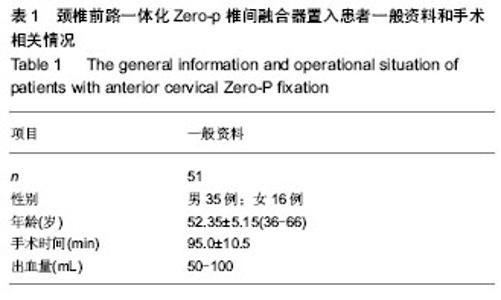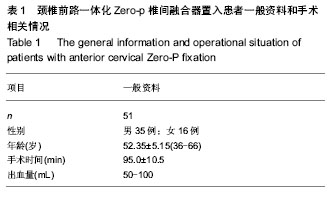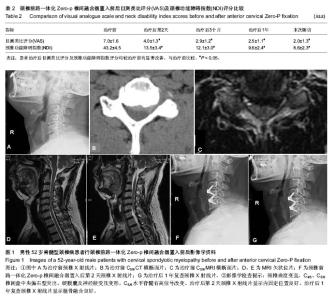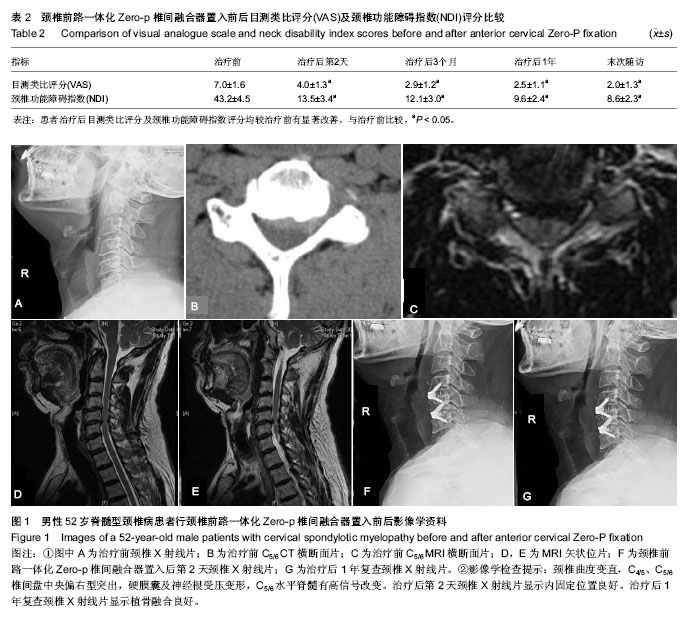| [1] Tracy JA,Bartleson JD.Cervical spondylotic myelopathy. Neurologist.2010,3: 176-187.
[2] Anderson DG, Albert TJ.Bone grafting, implants, and plating options for anterior cervical fusions, Orthop Clin North Am. 2002;33(2):317-328.
[3] Fraser JF, Hartl R.Anterior approaches to fusion of the cervical spine: a metaanalysis of fusion rates.J Neurosurg Spine.2007;6:298-303.
[4] Lee MJ, Bazaz R, Furey CG,et al.Risk factors for dysphagia after anterior cervical spine surgery: a two-year prospective cohort study.Spine J. 2007; 7:141-147.
[5] Garrido BJ, Wilhite J, Nakano M, et al.Adjacent-level cervical ossification after Bryan cervical disc arthroplasty compared with anterior cervical discectomy and fusion.J Bone Joint Surg Am.2011;93(13):1185-1189.
[6] Park JB, Cho YS, Riew KD.Development of adjacent-level ossification in patients with an anterior cervical plate, J Bone Joint Surg Am. 2005;87:558-563.
[7] Scholz M, Reyes PM, Schleicher P,et al.A new stand-alone cervical anterior interbody fusion device: biomechanical comparison with established anterior cervical fixation devices.Spine (Phila Pa 1976).2009;34:156-160.
[8] Scholz M, Schnake KJ, Pingel A,et al.A new zero-profile implant for stand-alone anterior cervical interbody fusion.Clin Orthop Relat Res. 2011;469(3):666-673
[9] Yue WM, Brodner W, Highland TR.Persistent swallowing and voice problems after anterior cervical discectomy and fusion with allograft and plating: a 5- to 11-year follow-up study, Eur Spine J.2005;14:677-682.
[10] Hofstetter CC, Kesavabhotla K, Boockvar JA.Zero-profile Anchored Spacer Reduces Rate of Dysphagia Compared to ACDF With Anterior Plating.J Spinal Disord Tech.2013 Nov 7. [Epub ahead of print].
[11] Lee MJ, Bazaz R, Furey CG,et al.Influence of anterior cervical plate design on Dysphagia: a 2-year prospective longitudinal follow-up study, J Spinal Disord Tech.2005;18:406-409.
[12] 伍少玲,马超,伍时玲,等.颈椎功能障碍指数量表的效度与信度研究[J].中国康复医学杂志,2008,23(7):625-628.
[13] 日本骨科学会.颈部脊椎症性脊髓症治疗成绩判断基准[J].日本整形外科学会杂志,1975,(99):1-2.
[14] 包肇华,邹俊,朱若夫,等新型颈椎前路椎间融合固定系统(Zero-P)治疗颈椎病的疗效分析[J].中国骨与关节外科,2013,6(2):109-112.
[15] 陈凯,陈超,朱晓东,李明. Zero-P用于颈椎前路手术的早期临床疗效分析[J].脊柱外科杂志,2012,10(3):155-158.
[16] Phillips FM, Lee JY, Geisler FH, et al.A prospective, randomized, controlled clinical investigation comparing PCM cervical disc arthroplasty with anterior cervical discectomy and fusion. 2-year results from the US FDA IDE clinical trial.Spine (Phila Pa 1976).2013;38:E907-918.
[17] Mendoza-Lattes S, Clifford K, Bartelt R,et al.Dysphagia following anterior cervical arthrodesis is associated with continuous, strong retraction of the esophagus.J Bone Joint Surg Am.2008;90:256-263.
[18] 祁敏,梁磊,袁文等.颈前路多节段融合术后吞咽困难的原因分析[J].中华骨科学杂志,2013,33(5):467-472.
[19] Park JY, Zhang HY, Oh MC.New technical tip for anterior cervical plating : make hole first and choose the proper plate size later.J Korean Neurosurg Soc.2011;49:212-216.
[20] Ji GY, Oh CH, Shin DA, et al.Stand-alone Cervical Cages versus Anterior Cervical Plates in Two-Level Cervical Anterior Interbody Fusion Patients: Analysis of Adjacent Segment Degeneration. J Spinal Disord Tech.2013 Jul 26. [Epub ahead of print].
[21] 黄吉军,杨建东,陶玉平,等.颈椎Zero-P植入与前路减压植骨融合术的对照研究[J].实用骨科杂志,2014,20(4):289-292.
[22] 许怀波,周美平,侯波,等.ZERO-P在前路颈椎椎间融合术中临床应用效果的分析[J].中国现代药物应用,2013,7(13):65-66.
[23] 王治栋,朱若夫,杨惠林,等.前路减压Zero-p椎间融合器与传统钛板联合cage融合内固定治疗脊髓型颈椎病的疗效比较[J].中国脊柱脊髓杂志,2013,23(5):440-444.
[24] 汪冉.ACIF在颈前路减压融合术的应用[J].第21届中国康协肢残康复学术年会暨第二届“泰山杯”全国骨科青年科技创新论坛[C]. 泰安:2012.
[25] 祁敏,梁磊,陈华江,等. ACDF术式中采用Zero-p颈椎椎间融合器置入治疗颈椎病的学习曲线[J].中国矫形外科杂志,2013, 21(3): 213-216.
[26] 张亮,王静成,冯新民,等.零切迹颈前路椎间融合固定系统早期疗效分析[J].实用骨科杂志,2013,19(11):961-965.
[27] 陈扬,赵忠玮,郭伟壮,等.ZERO-P内固定系统应用于颈前路椎间融合术的临床观察[J].中国骨与关节损伤杂志,2013,28(9): 845-846.
[28] 魏鲁青,曾昭勇,张健平,等.Zero-P颈椎前路融合治疗颈椎病8例临床观察[J].当代医学,2013,(34):84-85.
[29] 祁敏.ACDF术式中采用Zero-p颈椎椎间融合器植入治疗颈椎病的近期疗效分析[C]. 银川:第三届全国脊髓损伤治疗与康复研讨会,2012.
[30] 缪锦浩,匡勇,陈德玉,等.颈前路减压零切迹椎间植骨融合内固定系统治疗颈椎病的早期疗效分析[J].中国脊柱脊髓杂志,2012, 22(6):536-540.
[31] 廖壮文,黄彦,范子文,等.微创小切口零切迹颈前路椎间融合器治疗单节段脊髓型颈椎病的疗效评价[J].中国矫形外科杂志,2012, 20(24):2250-2254.
[32] 祁敏,陈华江,杨立利,等.采用新型Zero-p颈椎椎间融合器置入治疗颈椎病的近期疗效分析[J].中国矫形外科杂志,2012,20(24): 2232-2236.
[33] 刘才俊,吴增晖,张奎渤,等.零切迹椎间融合内固定系统Zero-P在颈椎前路手术中的应用[J].中国骨科临床与基础研究杂志,2012, 4(3):178-183.
[34] 汪冉.Zero-P零切迹颈椎前路椎间融合固定系统(ACIF)在颈前路减压融合术的应用[J].银川:第三届全国脊髓损伤治疗与康复研讨会[C]. 2012.
[35] 汪冉,王炤,赵志芳.ACIF 在颈前路减压融合术的应用[J].颈腰痛杂志,2012,33(6):428-431. |



